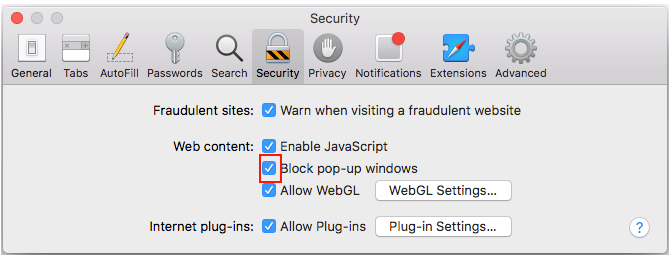

- #Safari pop ups mac how to#
- #Safari pop ups mac for mac#
- #Safari pop ups mac for android#
- #Safari pop ups mac plus#
- #Safari pop ups mac windows#
With Safari in macOS Monterey, you can allow or block pop-ups on individual websites or all websites. Other websites might fill your screen with pop-up ads. For example, a bank website might show your monthly statements in pop-ups. In fact, some websites require you to allow pop-ups. However, some that appear legitimate or useful websites can be helpful.
#Safari pop ups mac windows#
Pop-up windows can be unwanted or annoying. What is a pop-up window?Ī pop-up is a graphical user interface (GUI) display that usually pops up in a small window in the foreground of Safari’s visual interface.
/img_02.png)
Conveniently, Safari on macOS Monterey allows you to choose which ones will pop up and which ones won’t. You should keep this in mind when using these third-party apps as the majority of them possess this capability.Let’s face it: Pop-up windows on web browsers can be annoying. When you visit a site where you need pop-ups, click on the AdBlock icon and find a way to add the site to your whitelist, or disable the block for that specific site. However, you may need to enable pop-up windows in these apps as well, as they may incorrectly identify and block innocent pop-ups. As you can see in the image, external apps provide a visual indicator of the present number of ads they have blocked.
#Safari pop ups mac plus#
Third-party ad-blocking apps like Adblock Plus get rid of ads and pop-ups. Note: You can also access the pop-up settings by entering chrome://settings/content/popups in the address bar. You can click this icon to allow the pop-up or choose to allow pop-ups from that particular site. When a page in Chrome blocks pop-ups, you will see a small icon in the address bar called Pop Up Blocked, which looks like a window with an X on it. Step 5: You also have an option to automatically allow pop-ups from any site you visit in Chrome. This works well if you have another list of allowed sites that you can copy and paste into Chrome and save. Step 4: Under Allow, you can manually add individual sites to the pop-up Allow list. You’ll see a new page with an option to toggle between Blocked (Recommended) and Allowed. Step 3: Select Site Settings, scroll down, and click Pop-Ups and Redirects. To the right, you should see a list of options, with Privacy and Security among them.

Step 1: With a Chrome browser window open, click Chrome listed in the top-left corner, followed by Preferences on the resulting drop-down menu. The steps illustrated below explains how Chrome manages pop-ups and how you can deal with them manually.
#Safari pop ups mac for android#
Enable pop-ups on ChromeĬhrome is a popular browser for Android and Mac owners alike. You can add as many websites as you want to your exceptions, and remove them as needed when you are done. This opens a new window where you can manually enter the website’s address - use the copy/paste method - and click the Allow and Save Changes buttons. Step 4: If you don’t want to enable all pop-ups, use the Exceptions button instead. Step 3: Uncheck the box next to Block Pop-Up Windows to enable pop-ups for all websites. Step 2: In the new Preferences tab, click Privacy & Security listed on the left, and scroll down to the Permissions section. Step 1: While in a Firefox window, select Firefox in the top-left corner, followed by Preferences in the resulting drop-down menu. If you use Firefox, take a look at how you can enable pop-ups within Mozilla’s popular browser:
#Safari pop ups mac for mac#
Enable pop-ups on Firefoxįirefox is also a very common browser choice for Mac users, even more so since its Quantum revamp. It’s not a great way to manage pop-ups in general, but it is useful if you occasionally view a pop-up but don’t want to change any of your settings permanently. Just click on the notification, and Safari will give you an option to view the pop-up. If you need this pop-up to enable a feature, then you can quickly retrieve it. Step 4: Finally, when Safari actively blocks a pop-up, a little notification appears in the browser’s address bar to let you know it happened. If you want to allow pop-ups on all websites, select Allow on the drop-down menu next to When Visiting Other Websites located at the bottom. Step 3: To enable pop-ups on a specific website, click the drop-down menu next to the website’s name and click Allow. Step 2: In a pop-up window, click the Websites tab at the top, followed by the Pop-up Windows entry on the left. Step 1: With Safari active, click Safari located in the top-left corner, followed by Preferences in the resulting drop-down menu. The default browser on your Mac makes managing pop-ups very simple.
#Safari pop ups mac how to#
We’ll show you how to enable pop-ups on a Mac, no matter what browser you’re using. Fitbit Versa 3īrowser, such as Safari, Firefox, or Chrome


 0 kommentar(er)
0 kommentar(er)
